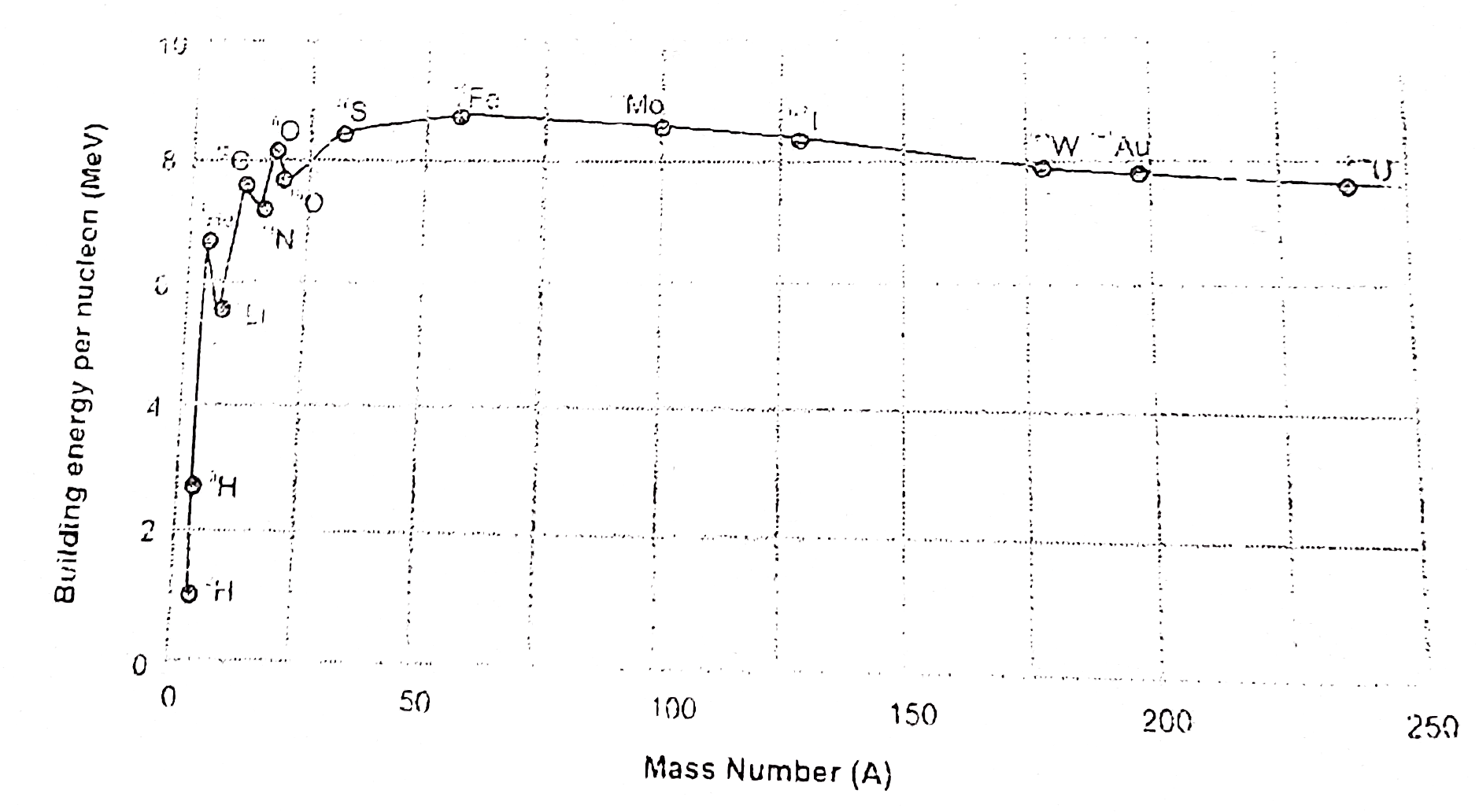When the number of nucleons in a nuclues increases the binding energy per nucleon
increases continuously with mass number
decreases continuously with mass number
remians constant with mass number
first increases and then decreases with increases of mass number
The correct Answer is:D
To solve the question regarding the relationship between the number of nucleons in a nucleus and the binding energy per nucleon, we can follow these steps:
Step 1: Understand the Concept of Binding Energy
Binding energy is the energy required to disassemble a nucleus into its individual nucleons (protons and neutrons). The binding energy per nucleon is the binding energy divided by the total number of nucleons in the nucleus.
Hint: Recall that binding energy is a measure of the stability of a nucleus.
Step 2: Define Nucleons
Nucleons refer to the particles found in the nucleus, which include protons and neutrons. The total number of nucleons in a nucleus is known as the mass number (A).
Hint: Remember that mass number (A) = Number of protons (Z) + Number of neutrons (N).
Step 3: Analyze the Binding Energy Curve
The binding energy per nucleon versus mass number curve shows how the binding energy changes as the number of nucleons increases. Initially, as the mass number increases, the binding energy per nucleon increases.
Hint: Look for patterns in the binding energy curve, especially around the region of iron (Fe).
Step 4: Identify the Maximum Point
For elements around iron (specifically iron-56), the binding energy per nucleon reaches a maximum value of approximately 8.8 MeV. Beyond this point, as the mass number continues to increase, the binding energy per nucleon starts to decrease.
Hint: Consider why iron is often referred to as the most stable nucleus.
Step 5: Conclude the Relationship
From the analysis, we conclude that as the number of nucleons in a nucleus increases, the binding energy per nucleon first increases, reaches a maximum, and then decreases. Therefore, the statement "when the number of nucleons in a nucleus increases, the binding energy per nucleon first increases and then decreases" is correct.
Hint: Summarize the behavior of binding energy per nucleon in relation to mass number.
Final Answer
The binding energy per nucleon first increases with an increase in the number of nucleons, reaches a maximum around iron-56, and then decreases as the mass number continues to increase.
Binding energy is the energy required to disassemble a nucleus into its individual nucleons (protons and neutrons). The binding energy per nucleon is the binding energy divided by the total number of nucleons in the nucleus.
Nucleons refer to the particles found in the nucleus, which include protons and neutrons. The total number of nucleons in a nucleus is known as the mass number (A).
The binding energy per nucleon versus mass number curve shows how the binding energy changes as the number of nucleons increases. Initially, as the mass number increases, the binding energy per nucleon increases.
For elements around iron (specifically iron-56), the binding energy per nucleon reaches a maximum value of approximately 8.8 MeV. Beyond this point, as the mass number continues to increase, the binding energy per nucleon starts to decrease.
From the analysis, we conclude that as the number of nucleons in a nucleus increases, the binding energy per nucleon first increases, reaches a maximum, and then decreases. Therefore, the statement "when the number of nucleons in a nucleus increases, the binding energy per nucleon first increases and then decreases" is correct.
The binding energy per nucleon first increases with an increase in the number of nucleons, reaches a maximum around iron-56, and then decreases as the mass number continues to increase.
Topper's Solved these Questions
- NUCLEIBOOK - DC PANDEY ENGLISHCHAPTER - NUCLEIEXERCISE - B Medical entrance special format questions
9 Videos
- NUCLEIBOOK - DC PANDEY ENGLISHCHAPTER - NUCLEIEXERCISE - MATCH THE COLUMNS
4 Videos
- NUCLEIBOOK - DC PANDEY ENGLISHCHAPTER - NUCLEIEXERCISE - CHECK POINT 13.3
15 Videos
- MODERN PHYSICS - 2BOOK - DC PANDEY ENGLISHCHAPTER - MODERN PHYSICS - 2EXERCISE - Level 2 Subjective
10 Videos
- RAY OPTICSBOOK - DC PANDEY ENGLISHCHAPTER - RAY OPTICSEXERCISE - Medical entrance gallary
76 Videos
Similar Questions
The value of binding energy per nucleon is
View SolutionAssertion: The nuclear energy can be obtained by the nuclear fission of heavier nuclei as well as by fusion of lighter nuclei.
Reason: As the mass number increases, the binding energy per nucleon, first increases and then decreases.
View SolutionAs the mass number A increases, the binding energy per nucleon in a nucleus.
View SolutionNumber of nucleons in D2 molecule is
View SolutionNumber of nucleons in D2 molecule is
View SolutionThe number of nucleons in chlorine - 37 is
View Solutionwhen two nuclei (A≤10) fuse together to form a heavier nucleus, the (a) binding energy per nucleon increases (b) binding energy per nucleon decreases (c) binding energy per nucleon does not change (d) total binding energy decreases
View SolutionAssertion : Nuclei having number about 60 are most stable.
Reason : When two or more light nuclei are combined into a heavier nucleus, then the binding energy per nucleon will increase.
View SolutionFour nuclei of an elements undergo fusion to form a heavier nucles, with release of energy. Which of the two - the parent or the daughter nucleus - would have higher binding energy per nucleon ?
View SolutionDraw the graph showing thervariation of binding energy per nucleon with mass number. Give therason for the decrease of binding energy per nucleon for nuclei with high mass numbers.

The binding energy per nucleon for nuclei with high mass number is low due to the large coulomb repulsion between the protons inside these nuclei.
View Solution
